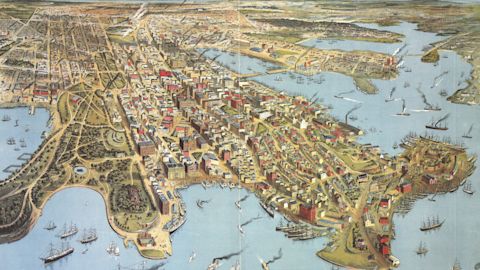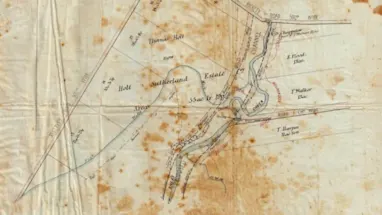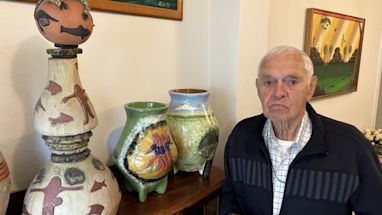Sydney’s inner neighbourhoods are rich with stories – some well-known, others passed down quietly through families and communities.
We’re shining a light on 6 local areas through the voices of people who lived, worked and grew up there. Drawing from our oral history and archives collections, we unearth lesser-known personal stories and moments in time to reveal the rich and often hidden history of our villages.

Darlinghurst
In the 1960s, a scattering of nightclubs began to appear along Oxford Street, catering to people of diverse sexualities and genders. Over the following decades, more bars, clubs, restaurants, saunas and shops opened, earning the strip its celebratory nickname: ‘The Golden Mile’. It soon became synonymous with LGBTIQA+ life in Sydney.
Johnny Allen, born in Glen Innes and educated at a conservative Catholic school, couldn’t get to Darlinghurst fast enough after finishing school in the 1970s. There, he found kindred ‘outsiders’ and quickly immersed himself in the vibrant cabaret and music scene blossoming along Oxford Street.
Inspired by the gay liberation politics of the time, Johnny went on to establish the Gay Men’s Rap, the Gay Theatre Company, Cabaret Conspiracy, and Sydney’s first gay film festival. In his oral history interview, he offers a vivid account of life in Darlinghurst – the clubs, the performers, the people – and the underground party scene that moved from venue to venue throughout the area.
Learn more
Listen to an audio excerpt where Johnny Allen talks about feeling at home among the LGBTIQA+ community in the 1970s, the party scene on Oxford Street, the cabaret nights and other events around Darlinghurst.
Listen to Johnny’s full oral history interview.
Learn about the rich history of Darlinghurst through the edited publication, My Darlinghurst. The book is available to borrow through our library network.
Explore Darlinghurst’s ‘Golden Mile’ on foot with the Parade walking tour.
Learn more about Darlinghurst by researching the City of Sydney's Archives and History Resources catalogue.

Redfern
Throughout the 20th century, political activism grew in Sydney’s Aboriginal community, leading to the creation of facilities and institutions developed by – and for – urban Aboriginal people. Redfern became a key hub for activism around civil and land rights, and several organisations central to the movement for self-determination were established there.
One of these was Murawina Early Childhood Education Centre, founded in 1973 by and for the community. Wiradjuri woman Norma Ingram, a long-time leader in Indigenous affairs, was Murawina’s first administrator.
In her oral history interview, Norma places Murawina in the context of the 1970s radical black political movement. She speaks about the centre’s educational philosophy and how they developed a culturally appropriate model for Aboriginal and Torres Strait Islander children. At first, Murawina was run by untrained mothers. But with funding from the Whitlam federal government for wages and teacher training, it became a vital part of educating Aboriginal children in inner-city Sydney.
Learn more
Listen to an audio excerpt where Norma Ingram talks about the pre-school readers developed at Murawina as part of a culturally appropriate program.
Listen to Norma’s full oral history interview.
Learn more about Murawina and other histories from Redfern’s past and present, including the civil rights movement, work and life, as well as significant people and events on the Barani website. The Dictionary of Sydney also has information on the development and success of Murawina.
Explore the Barani Redfern walking tour on the Sydney Culture Walks app.
Learn more about Redfern by researching the City of Sydney’s Archives and History Resources catalogue.

Haymarket
Haymarket takes its name from the markets that once dominated the area throughout the 19th and 20th centuries. Originally Sydney’s industrial backyard, its first buildings were factories, workshops and homes for some of the city’s poorest residents. Over time, it became a bustling warehouse and market precinct, and eventually evolved into the vibrant, multicultural hub we know today.
From the 1870s, Haymarket and nearby Surry Hills became a centre for Sydney’s Chinese community. Chinese market gardeners brought their produce to town, often staying for a night or 2 until everything was sold. To support them, boarding houses, cookhouses and shops began to appear on Goulburn, Pitt and Campbell streets, creating the foundation for what would become Chinatown.
By the early 20th century, Dixon Street had become the heart of Sydney’s Chinese community – marking the city’s third Chinatown. Dixon Street Mall, with its iconic ceremonial arches (damen) at either end, officially opened in 1980. The gates were heritage-listed in 2024 and are now being carefully restored.
The City of Sydney’s ongoing revitalisation of Chinatown and Thaitown has brought new life to this historic part of Haymarket, celebrating both its past and its vibrant present.
Learn more
Listen to Shirley Lee, Susan Pang and Jack Ah Yong share their memories of the Hingara Chinese Restaurant in Haymarket or explore more local stories in the City of Sydney’s Oral History collection.
Learn about the Aboriginal history in the city’s south, including the Darling Walk Midden found in 2009, and the influence of the Trades Hall and the Foundation for Aboriginal Affairs on the lives of Aboriginal people.
Explore the stories of the city’s south on our Community history walk leading you to Sydney’s historic markets, shops, business premises and entertainment venues.
Learn more about Haymarket or the city’s markets by researching the City of Sydney’s Archives and History Resources catalogue.

Sydney city
Long before the grid of city streets we know today, informal paths behind Sydney’s earliest main roads gave settlers access to rear gardens, stables and storage areas.
Over time, new laneways emerged to provide access to the growing number of commercial buildings. Whether tucked-away gems or a grungy service lane, each one adds a layer to the city’s unique urban tapestry.
Since 2008, the City of Sydney has used public art to invite people to rediscover these fine-grain spaces. A temporary art program has transformed laneways into places of creativity and connection. One of the most loved examples is Forgotten Songs in Angel Place. Once a temporary installation, it is now permanent, commemorating the songs of 50 native birds that once filled the air in central Sydney, before being silenced by urban development.
Learn more
Listen to artist Michael Thomas Hill’s interview about his public artwork Forgotten Songs in Central Sydney’s Angel Place.
Learn how Sydney’s earliest streets followed paths long used by local Aboriginal people, while others were cut through the bush by chain gangs or followed goat and bullock tracks.
Want to explore more? Pop your walking shoes on and weave your way through the past along the city’s network of laneways on our Hidden history walk.

Newtown
Camperdown Memorial Rest Park in the heart of Newtown holds memories both visible and invisible in its cemetery. Established in 1848, the cemetery became the final resting place for more than 18,000 people in just 18 years. Many were buried in unmarked graves, including Aboriginal people, whose stories are still being uncovered.
A sandstone obelisk erected in 1943 commemorates the memory of the Aboriginal people buried at the cemetery. Historical records and death certificates provide glimpses into some of these burials, offering insight into lives once lived.
One early burial was that of Tommy, an 11-year-old boy buried in 1863. Newspapers at the time suggest he lived with a non-Aboriginal carer in Paddington. His occupation as a labourer hints he may have come to Sydney for work, but it’s unclear if he had any choice in the matter.
Learn more
Learn about this historic cemetery in Newtown by researching the City’s Archives and History Resources catalogue. Find photographs, plans and books that document its history. Find out more about the history of Gadigal Newtown in this essay available in the archives.
Explore the Camperdown Memorial Rest Park and Cemetery on foot, one of the many stops on the city’s Gritty history walk of Newtown.

Glebe
Did you know that Glebe has one of the oldest Chinese temples in NSW? One of just 4 temples of its kind in Australia, the Sze Yup Temple on Edward Street remains a treasured part of the suburb’s cultural heritage. It’s not the only hidden gem in this suburb which was originally set aside for the Church of England.
In the 19th century, the Glebe Point area became fashionable, while the southern part of Glebe became a working-class district. After falling into decline in the early 20th century, there was a renewed appreciation of its charms in the 1960s, and it became one of the first suburbs in Australia to experience ‘gentrification’.
The suburb’s architectural heritage, combined with proximity to the city and University of Sydney, made it fashionable again. Explore our resources and discover the Glebe area which has not only a fascinating built environment but a long history of bohemian lifestyle, activism and intellectual pursuits.
Learn more
Listen to a former resident Richard Childs recalling living in ‘ramshackle’ Glebe in the 1970s.
Learn more about the Sze Yup Temple in the City of Sydney’s Archives collection and other photographs, maps and stories about Glebe.
Explore Sze Yup Taoist temple and other Glebe stories on our Preservation history walk.
Discover Glebe’s significant connections with Aboriginal people such as boxer Dave Sands after whom Dave Sands Lane was named, and Aboriginal services such as Tranby Aboriginal Co-operative Limited.
Enjoy a walk along Glebe’s foreshore and learn about the history of its parks.
Want more?
Continue exploring the theme of "Unearthed" and check out all the events happening for Australian Heritage Festival.
Published 28 April 2025, updated 30 April 2025



